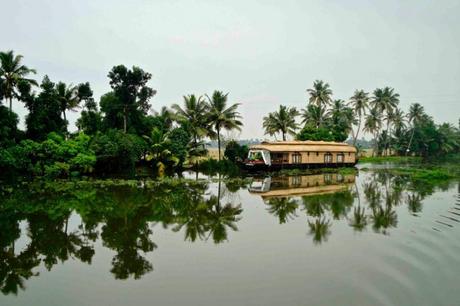 The area’s long history as a spice center secured its relative wealth, though an unusual history—one that includes a rare confluence of Catholics, Christians and Communists—ensured its prosperity and uniqueness. With Kerala’s progressive Maharajas supporting free public education, 19th century missionaries got busy scattering the landscape with churches and schoolhouses, while promoting the modern notion that girls, as well as boys, deserved instruction.
The area’s long history as a spice center secured its relative wealth, though an unusual history—one that includes a rare confluence of Catholics, Christians and Communists—ensured its prosperity and uniqueness. With Kerala’s progressive Maharajas supporting free public education, 19th century missionaries got busy scattering the landscape with churches and schoolhouses, while promoting the modern notion that girls, as well as boys, deserved instruction.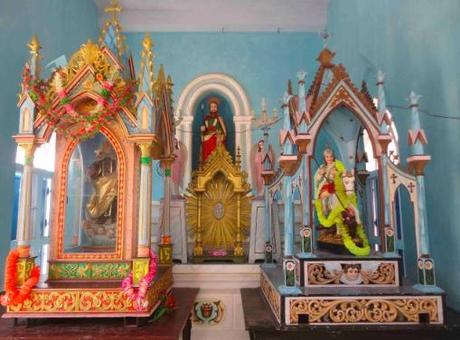 By 1956, Keralites—well-informed, dual-lingual, 20% Christian—commenced voting in Socialist candidates; a stance they’ve stuck with for the last half a century, much to the chagrin of India’s centrist federal government. In a country famed for political chicanery where huge swathes of the population remain so destitute and illiterate they vote by selecting the symbol—cricket bat, elephant, lotus flower, scooter—ascribed to whatever party is doingnothingfor them this year, this striking autonomy has served them well. With educated, socially conscious, locals implementing the full roster of left wing goodies: land reform, public health care, trade unions, workers cooperatives, a women’s movement, while rejecting the India’s discriminatory caste system.
By 1956, Keralites—well-informed, dual-lingual, 20% Christian—commenced voting in Socialist candidates; a stance they’ve stuck with for the last half a century, much to the chagrin of India’s centrist federal government. In a country famed for political chicanery where huge swathes of the population remain so destitute and illiterate they vote by selecting the symbol—cricket bat, elephant, lotus flower, scooter—ascribed to whatever party is doingnothingfor them this year, this striking autonomy has served them well. With educated, socially conscious, locals implementing the full roster of left wing goodies: land reform, public health care, trade unions, workers cooperatives, a women’s movement, while rejecting the India’s discriminatory caste system.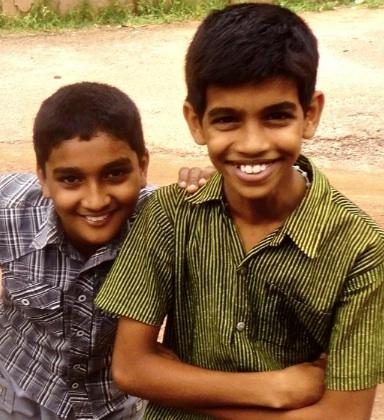 All in all, the sort of social construct that would give Mitt Romney a Hemiplegic migraine. For their efforts, Kerala ranks today as India’s least corrupt state, and its cleanest, while boasting the nation’s longest life expectancy, highest rating on the Human Development Index, and densest concentration of media; publishing newspapers in nine different languages. Given their advanced skill-sets, its youth are noted for leaping on 21stcentury BRIC economic opportunities and excelling at white-collar vocations. Proving that the best cure for extremism is an thriving middle-class, Kerala’s peaceful community of 35 million Hindus (60%), Muslims (20%) and Christians (20%) shun religious conflict, sidestepping the clashes that occurs in parts of India mired in crushing, everyday poverty. But I digress, America.Theotheramazing thing about this verdant and unique patch of India, rich in pepper, natural rubber, coconut, tea, coffee, cashews, and spices, is its bucolic backwater network of lagoons and canals. Edged in lotus-flowering rice paddies and coconut groves, slowly gliding along these picturesque waterways, some stretching as long as the 150 mile Periyar River, others so slight they’re fed entirely by the June through September Monsoon rains, is one of life’s great tranquil experiences. Languid and thoughtful, the scent of cardamom in the air, an afternoon’s drift along these Indian estuaries is the travel equivalent of the Slow Food Movement.
All in all, the sort of social construct that would give Mitt Romney a Hemiplegic migraine. For their efforts, Kerala ranks today as India’s least corrupt state, and its cleanest, while boasting the nation’s longest life expectancy, highest rating on the Human Development Index, and densest concentration of media; publishing newspapers in nine different languages. Given their advanced skill-sets, its youth are noted for leaping on 21stcentury BRIC economic opportunities and excelling at white-collar vocations. Proving that the best cure for extremism is an thriving middle-class, Kerala’s peaceful community of 35 million Hindus (60%), Muslims (20%) and Christians (20%) shun religious conflict, sidestepping the clashes that occurs in parts of India mired in crushing, everyday poverty. But I digress, America.Theotheramazing thing about this verdant and unique patch of India, rich in pepper, natural rubber, coconut, tea, coffee, cashews, and spices, is its bucolic backwater network of lagoons and canals. Edged in lotus-flowering rice paddies and coconut groves, slowly gliding along these picturesque waterways, some stretching as long as the 150 mile Periyar River, others so slight they’re fed entirely by the June through September Monsoon rains, is one of life’s great tranquil experiences. Languid and thoughtful, the scent of cardamom in the air, an afternoon’s drift along these Indian estuaries is the travel equivalent of the Slow Food Movement.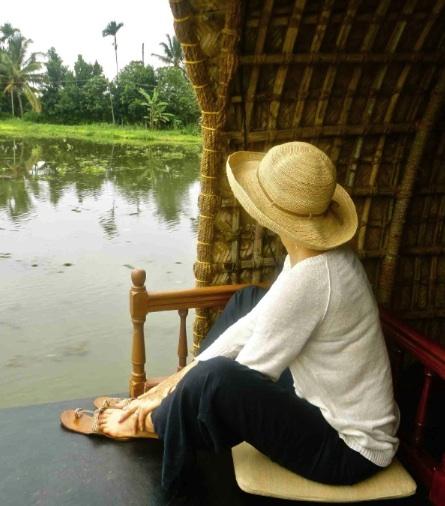 Houseboatsalong the waterways have multiplied over the last decade and Kerala’s signature touring options now range from handcraftedkettuvallams—anjali wood hulls capped with a vaunted roof woven out of palm leaves—to sleek air-conditioned cruisers with white jacket staff.
Houseboatsalong the waterways have multiplied over the last decade and Kerala’s signature touring options now range from handcraftedkettuvallams—anjali wood hulls capped with a vaunted roof woven out of palm leaves—to sleek air-conditioned cruisers with white jacket staff.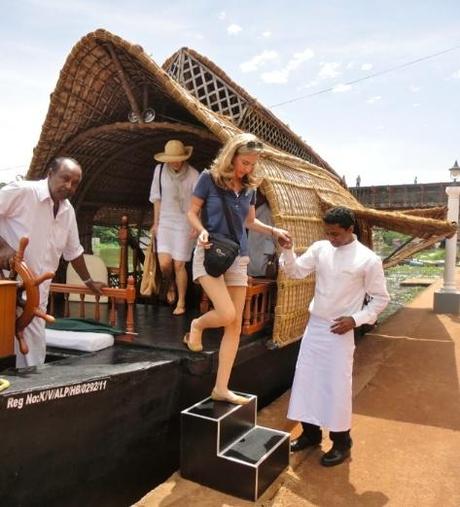 Sailing October through April, the most luxurious is theVrinda: Oberoi’s eight cabin motor cruiser with a rooftop sun deck which serves as your base with daily forays to locals villages and temples—as well as ornate churches—on a traditional kettuvallam.Beyond cooled cabins and dining areas, much welcome in the sultry climate of Kerala,the Vrinda highlights local South Indian cookery and culture. [Full disclosure: my girlfriend works for Oberoi and invited me to join her on this voyage]
Sailing October through April, the most luxurious is theVrinda: Oberoi’s eight cabin motor cruiser with a rooftop sun deck which serves as your base with daily forays to locals villages and temples—as well as ornate churches—on a traditional kettuvallam.Beyond cooled cabins and dining areas, much welcome in the sultry climate of Kerala,the Vrinda highlights local South Indian cookery and culture. [Full disclosure: my girlfriend works for Oberoi and invited me to join her on this voyage]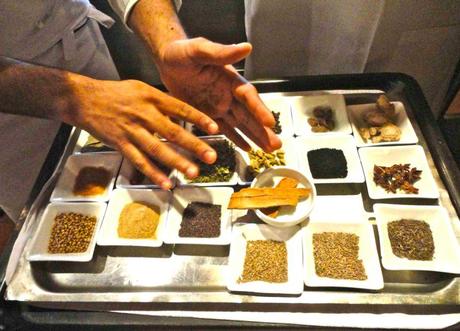 With three, seriously elaborate, daily meals and dinners followed by highly ritualized evening recitals by Kerala’s most sought after musicians, dancers and performers for a taste of local culture. If you like, there are cooking lessons as well. The area is rich with coconuts, bananas, rice, freshwater fish, crab, mussels and prawns, and every sort of spice, you’ll disembark with the skills to whip up a tasty Malabar fish curry when you get home.
With three, seriously elaborate, daily meals and dinners followed by highly ritualized evening recitals by Kerala’s most sought after musicians, dancers and performers for a taste of local culture. If you like, there are cooking lessons as well. The area is rich with coconuts, bananas, rice, freshwater fish, crab, mussels and prawns, and every sort of spice, you’ll disembark with the skills to whip up a tasty Malabar fish curry when you get home.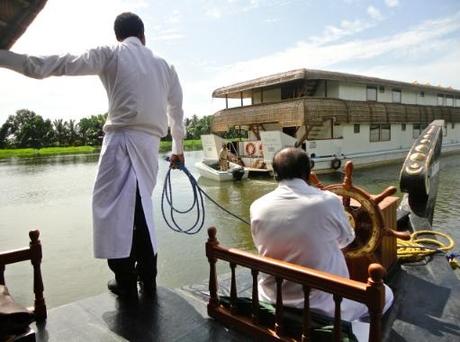 The Vrinda offers set 2 and 3 dayexcursions, but if you book the whole boat, you can tailor your experience. On the drive in or out, stop atPeriyar National Parkand trek through the jungle on an elephant. While on the rivers, organic health and beauty forays are innumerable—Kerala is the cradle of Aryuvedic medicine—expert herbal remedies are plucked fresh from the abundant supply of plants that flourish here.
The Vrinda offers set 2 and 3 dayexcursions, but if you book the whole boat, you can tailor your experience. On the drive in or out, stop atPeriyar National Parkand trek through the jungle on an elephant. While on the rivers, organic health and beauty forays are innumerable—Kerala is the cradle of Aryuvedic medicine—expert herbal remedies are plucked fresh from the abundant supply of plants that flourish here.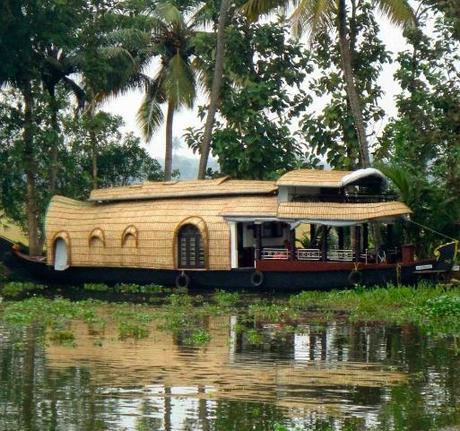 Of course, in India, a country with 330 million gods, temple festivals are as extravagant as they are frequent. A grand highlight on the social calendar and celebrated with musical processions, bejeweled elephants, colourful river floats, dancers, and fireworks, not to mention, regional costumes that are wildly ornate, even by the elaborate decorative standards of India. For a list see of local festivals, clickhere.
Of course, in India, a country with 330 million gods, temple festivals are as extravagant as they are frequent. A grand highlight on the social calendar and celebrated with musical processions, bejeweled elephants, colourful river floats, dancers, and fireworks, not to mention, regional costumes that are wildly ornate, even by the elaborate decorative standards of India. For a list see of local festivals, clickhere.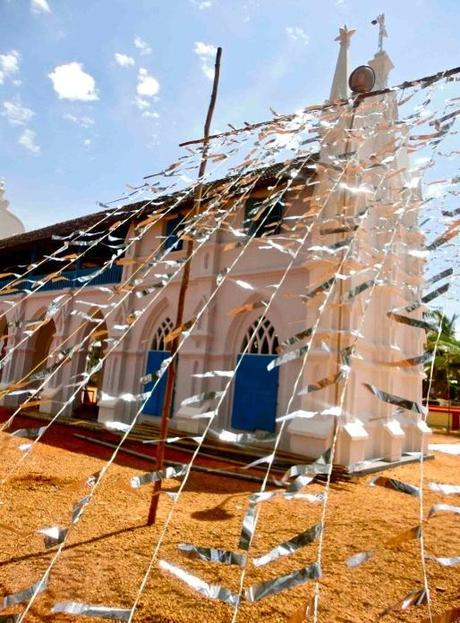 Keralites also enjoy a bracing snake boat race, a tradition they’ve honed over four centuries and trace back to the ancient kings of Alleppey who battled each other on these waters. Up to 120 feet in length and manned by as many as 100 rowers, each village takes enormous pride in their particular snake boat—and vanquishing competing hamlets during the July to September regattas. Most anticipated are the Nehru Trophy, held in memory of India’s late Prime Minister, and the Champakulam Moolam, which celebrates the Hindu God Krishna with a parade of boats decorated with performers and parasols.Of course, you may just be happy reading someaward winning Indian literature, while staring blissfully at the passing pastoral, an iced gin and tonic in your hand. Source: http://www.forbes.com/sites/viiabeaumanis/2013/01/14/kerala-cruising-the-indian-waterways/
Keralites also enjoy a bracing snake boat race, a tradition they’ve honed over four centuries and trace back to the ancient kings of Alleppey who battled each other on these waters. Up to 120 feet in length and manned by as many as 100 rowers, each village takes enormous pride in their particular snake boat—and vanquishing competing hamlets during the July to September regattas. Most anticipated are the Nehru Trophy, held in memory of India’s late Prime Minister, and the Champakulam Moolam, which celebrates the Hindu God Krishna with a parade of boats decorated with performers and parasols.Of course, you may just be happy reading someaward winning Indian literature, while staring blissfully at the passing pastoral, an iced gin and tonic in your hand. Source: http://www.forbes.com/sites/viiabeaumanis/2013/01/14/kerala-cruising-the-indian-waterways/

